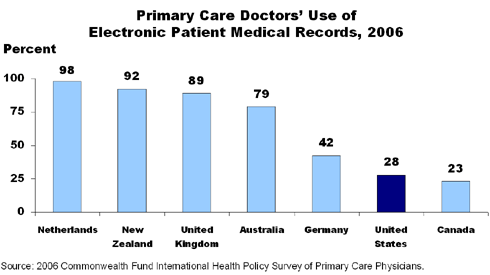In the article, “On the Front Lines of Care: Primary Care Doctors’ Office Systems, Experiences, and Views in Seven Countries” (Health Affairs Web Exclusive, Nov. 2, 2006), the authors report on survey results that reveal striking differences in primary care practice internationally–differences that highlight the importance of having national policies in place to support primary care. According to the survey, U.S. physicians are among the least likely to have extensive clinical information systems or quality-based payment incentives, the least likely to provide access to after-hours care, and the most likely to report that their patients often have difficulty paying for care.
The 2006 Commonwealth Fund/Harris Interactive survey included more than 6,000 PCPs in Australia, Canada, Germany, the Netherlands, New Zealand, the United Kingdom, and the United States (including more than 1,000 U.S. physicians).
For many people, the primary care physician (PCP) is their first point of contact with the health care system, as well as their main source of preventive and essential care. Recognizing the central role of PCPs in health care, international initiatives to improve health system performance have focused on developing systems and policies to enhance the effectiveness and efficiency of primary care practice. These include the use of clinical information systems, which assist doctors in treatment decisions and enable them to provide patient-centered care; multidisciplinary care teams and disease management programs for patients with chronic illness; and enhanced access to care, such as after-hours appointments.
Use of Information Technology
The survey revealed stark differences in PCPs’ access to information systems. Only 28 percent of U.S. doctors and 23 percent of Canadian doctors said they used electronic medical records (EMRs), compared with overwhelming majorities of doctors in the Netherlands (98%), New Zealand (92%), the U.K. (89%), and Australia (79%).
Canadian and U.S. doctors are also the least likely to have systems that provide decision support, such as computerized alerts about potentially harmful drug doses or interactions. Only 10 percent of Canadian doctors and 23 percent of U.S. doctors receive computerized alerts; rates elsewhere ranged from 93 percent (Netherlands) to 40 percent (Germany). Furthermore, at least two of five U.S. and Canadian doctors find it “very difficult” or “impossible” to identify patients overdue for a test or preventive care, versus one of five or fewer in the other countries.
Patients’ Access to Care
Doctors in the U.S. were least likely to say that their practices allow patients to see a nurse or doctor after regular office hours, without going to an emergency room–just 40 percent have such arrangements. In contrast, between 95 percent and 76 percent of doctors in the other countries provide after-hours care.
U.S. doctors were the most likely to report their patients have difficulty paying for care. Half (51%) of U.S. PCPs reported that patients often have difficulty paying for medications, compared with between 7 percent and 27 percent in the other countries.
Availability of Financial Incentives
Despite growing U.S. interest in financial incentives to improve performance, U.S. primary care doctors are among the least likely to receive such incentives. Just 30 percent reported receiving, or having the potential to receive, payments for managing chronic disease, achieving clinical targets, enhancing preventive care, or other quality improvement activities. The U.K. stands out as a leader in this regard: 95 percent of its doctors receive, or are able to receive, financial incentives for improved performance.
Chronic Care Management
Regarding the highly important dimension of managing chronic disease, a high proportion of doctors in all countries (25% to 30% or more), except Germany (7%), said they are not well-prepared to care for patients with multiple chronic conditions. There are wide variations in the use of care teams and systems known to improve outcomes for such patients.
Conclusions
Primary care physicians in the seven countries share many common challenges, among them improving coordination of care for patients with chronic disease. Yet, the survey highlights sharp differences in the availability of incentives, IT capacity, use of care teams, and patient access to care. These divergent experiences often reflect their country’s underlying policy choices, and the extent to which policies in place are national in scope. As physicians’ responses suggest, national policies in support of primary care matter. The U.S.–which lags well behind in use of health IT–appears to be the only country without a national IT plan. Moreover, the difficulty U.S. patients experience in paying for care signify a failure of the U.S. health insurance system to support primary care. “Cohesive, broad-based policy changes in the United States,” the authors conclude, “could lead to improved absolute and relative performance.”
Facts and Figures:
* Of 14 health information system functions assessed in the survey (e.g., automated alerts/reminders, electronic prescribing), fewer than one of five U.S. and Canadian physicians reported their offices supported seven or more of these functions. In the other countries, 59% to 83% of doctors reported such multifunctional capacity.
* Use of clinical teams to manage chronically ill patients varies widely, ranging from 73% in the U.K. to 25% to 38% in Canada, the U.S., and Australia.
* The U.K. stands out for their ability to track medical errors: 79% of U.K. doctors have systems to document all adverse events, compared with 7% to 41% in other countries (37% in the U.S.).

Citation: C. Schoen, R. Osborn, P. Trang Huynh, M. Doty, J. Peugh, K. Zapert, On The Front Lines of Care: Primary Care Doctors’ Office Systems, Experiences, and Views in Seven Countries, Health Affairs Web Exclusive (Nov. 2, 2006):w555–w571.
